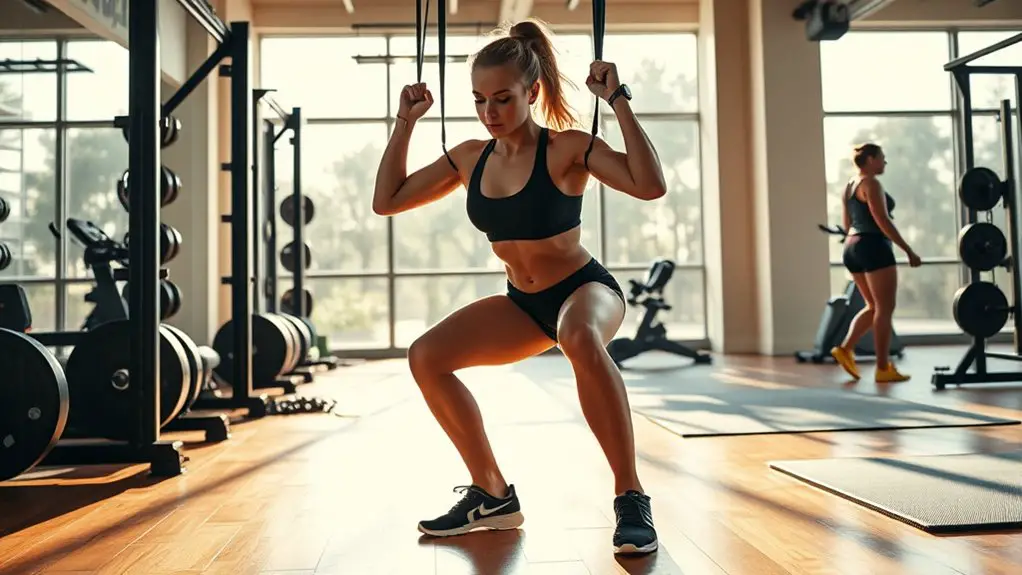Best Resistance Band Workouts for Gym-Goers

For gym-goers, resistance bands offer versatile workouts that enhance strength and flexibility. You can sculpt your arms with bicep curls, strengthen your shoulders with presses, and engage your core through banded twists. Don’t forget lower body exercises like squats and glute bridges to build powerful legs and glutes. When combined in a circuit, these bands can boost endurance and improve balance. Discover more tips and techniques to elevate your resistance band workouts.
Understanding Resistance Bands: Types and Benefits

Resistance bands are versatile tools that can transform your workout routine. You’ll find various types of bands—like flat bands, loop bands, and tube bands—each designed for specific exercises and resistance levels. Understanding these options helps you select the right band for your fitness goals and guarantees your safety during workouts.
The benefits of using resistance bands are numerous. They improve strength, flexibility, and balance, while also being gentle on joints. This makes them particularly appealing if you’re recovering from an injury or want to avoid strain.
When choosing bands, consider the materials used, such as latex or fabric. Latex bands offer excellent elasticity but may cause allergies, while fabric bands provide a softer grip and are less likely to snap. By selecting the right type and material, you can enhance your workout experience and stay safe as you strengthen your body.
Warm-Up: Essential Stretches With Resistance Bands
Warming up properly is essential for preventing injuries and enhancing your workout performance. With resistance bands, you can incorporate effective stretching techniques that target key muscle groups. Let’s explore some recommended resistance band stretches to get you started.
Benefits of Warm-Up
Before diving into your resistance band workout, it’s important to remember that a proper warm-up can greatly enhance your performance and reduce the risk of injury. A warm-up focuses on dynamic flexibility, preparing your muscles and joints for the workout ahead. Here are some benefits of warming up:
- Increases blood flow to muscles
- Improves joint mobility
- Enhances overall strength and power
- Promotes better coordination and balance
- Aids in injury prevention
Effective Stretching Techniques
While stretching might seem simple, incorporating resistance bands can greatly enhance your warm-up routine. These resistance band techniques promote dynamic flexibility, ensuring your muscles are primed for activity. Start with gentle band-assisted stretches to gradually increase your range of motion. For instance, use the band to support your leg as you perform leg swings, allowing for controlled movement without overstretching.
Additionally, consider shoulder stretches by holding the band above your head and pulling it down to engage your back muscles. This method helps prevent injury by properly warming up your body. Remember, it’s important to maintain controlled movements and avoid bouncing. With these effective techniques, you’ll not only feel more prepared but also protect yourself from potential strain during your workout.
Recommended Resistance Band Stretches
Incorporating resistance bands into your warm-up routine can greatly enhance your flexibility and prepare your muscles for the workout ahead. Using dynamic stretching with bands not only improves band mobility but also helps prevent injuries. Here are some recommended resistance band stretches to start your session safely:
- Band Pull-Aparts: Strengthens the shoulders and opens up the chest.
- Seated Band Hamstring Stretch: Targets tight hamstrings effectively.
- Standing Quad Stretch: Loosens the quadriceps, promoting mobility.
- Lateral Band Walks: Engages hip muscles and enhances stability.
- Overhead Band Stretch: Increases flexibility in the upper body.
Remember to perform each stretch gently, focusing on your breathing to guarantee you’re prepared for your workout.
Upper Body Workouts: Sculpting Arms and Shoulders
If you want to sculpt your arms and shoulders, resistance bands are a fantastic tool. You’ll find that band bicep curls, shoulder presses, and tricep extensions can really help you build strength and definition. Let’s explore these effective exercises to enhance your upper body workout routine.
Band Bicep Curls
Sculpt your arms and shoulders with band bicep curls, a simple yet effective exercise that targets your biceps and helps build definition. To guarantee you’re using proper band form, keep your elbows close to your body and engage your core throughout the movement. You can also explore different bicep variations for added challenge and muscle engagement.
- Start with light resistance to master the technique.
- Gradually increase resistance as your strength improves.
- Perform 3 sets of 10-15 reps for ideal results.
- Mix in hammer curls for varied muscle activation.
- Always warm up to prevent injury.
Incorporating these tips will help you safely achieve toned arms while enjoying the versatility of resistance bands.
Resistance Band Shoulder Press
The resistance band shoulder press is a fantastic exercise for building strength and definition in your shoulders and upper arms. Proper band positioning is key to maintaining shoulder stability during this exercise. Here’s a quick guide to help you set up:
| Step | Action | Tips |
|---|---|---|
| 1 | Stand on the band, feet shoulder-width. | Maintain good grip. |
| 2 | Hold the band at shoulder height. | Elbows should be bent. |
| 3 | Press upward until arms are straight. | Engage your core. |
| 4 | Lower back to the starting position. | Control your movement. |
| 5 | Repeat for desired reps. | Focus on your form. |
Remember to warm up before starting and listen to your body to prevent strain.
Tricep Extensions With Bands
After you’ve warmed up with the resistance band shoulder press, it’s time to target your triceps with tricep extensions. This exercise is excellent for enhancing tricep activation and sculpting your arms. Here’s how to perform them safely:
- Stand with feet shoulder-width apart, placing the band under your feet.
- Hold the band with both hands, keeping elbows close to your head.
- Extend your arms upward while maintaining tension in the band.
- Slowly lower back to the starting position, feeling the band resistance.
- Repeat for 10-15 reps, ensuring controlled movement to avoid strain.
Remember to engage your core and maintain a neutral spine throughout the exercise. This will help you maximize your workout while minimizing injury risk.
Core Strengthening: Engaging Your Abdominals
While many people associate resistance bands with upper body workouts, they can be incredibly effective for strengthening your core as well. By incorporating bands into your routine, you can enhance abdominal stability and promote core engagement, essential for overall strength and injury prevention.
Start with simple exercises like banded planks or standing rotations. For a banded plank, place the band around your back and hold each end with your hands on the ground. This setup challenges your core while maintaining stability.
You can also try seated band twists. Sit on the floor with your legs extended, anchoring the band under your feet and twisting your torso to engage your obliques.
Always pay attention to your form and avoid overextending. Focus on controlled movements to maximize safety and effectiveness. With consistent practice, you’ll notice improved core strength that supports your overall fitness goals.
Lower Body Exercises: Building Strong Legs and Glutes

When it comes to building strong legs and glutes, resistance bands are a game changer. You can enhance your squats, perfect your glute bridges, and enjoy the benefits of lateral band walks. Let’s explore how these exercises can elevate your lower body workout routine.
Squats With Resistance Bands
Squats with resistance bands are a game-changer for anyone looking to build strong legs and glutes. By adjusting band tension, you can increase the challenge of various squat variations, ensuring you engage your muscles effectively. Here are some benefits to evaluate:
- Improves stability and balance
- Enhances muscle activation in glutes and quads
- Allows for a customizable workout intensity
- Reduces joint strain compared to free weights
- Ideal for all fitness levels
To perform these squats safely, anchor the band under your feet while holding the ends at shoulder height. Keep your back straight and knees aligned with your toes. Incorporating resistance bands into your squats can transform your lower body workouts while minimizing injury risk.
Glute Bridges Technique
Building on the strength you’ve developed with squats, glute bridges are another fantastic exercise to target your glutes and hamstrings. To perform a basic glute bridge, lie on your back with your knees bent and feet flat on the floor. Place a resistance band just above your knees to guarantee proper resistance band positioning. As you lift your hips toward the ceiling, engage your core and squeeze your glutes at the top. Hold for a moment before lowering back down. You can explore glute bridge variations, like single-leg glute bridges, to increase difficulty. Always focus on maintaining a neutral spine and avoid overarching your back to guarantee safety during the exercise. Happy bridging!
Lateral Band Walks Benefits
Although many exercises target the lower body, lateral band walks are especially effective for strengthening your legs and glutes. This exercise not only enhances muscle activation but also promotes injury prevention by stabilizing your hips and knees. By incorporating lateral band walks into your routine, you can enjoy several benefits:
- Targets gluteus medius for better stability
- Improves overall lower body strength
- Enhances balance and coordination
- Increases flexibility in the hip area
- Reduces the risk of lower body injuries
Be certain to use proper form and a resistance band that suits your fitness level. Start slow, and gradually increase the intensity to guarantee you’re building strength safely and effectively.
Full-Body Workouts: Combining Muscle Groups

When you’re looking to maximize your workout efficiency, full-body resistance band workouts that combine multiple muscle groups can be a game-changer. These workouts promote full body synergy, ensuring that you’re not just isolating one area but engaging several muscle groups simultaneously. By integrating muscle group exercises, you can achieve a thorough workout that saves time while enhancing strength and coordination.
Consider movements like the resistance band squat to press, which activates your legs, core, and shoulders all at once. This type of workout not only builds strength but also improves balance and flexibility, keeping your body functioning safely and effectively.
Always focus on maintaining proper form to prevent injury, and start with a resistance level that feels comfortable for you. Gradually increase the intensity as you gain confidence and strength. With consistent practice, you’ll reap the benefits of full-body workouts, ensuring a balanced and robust fitness routine.
Resistance Band Circuit Training: Boosting Endurance
If you want to take your fitness to the next level, resistance band circuit training is an effective way to boost endurance. This type of workout not only enhances endurance improvement but also keeps your routine fresh with circuit variations. Here are some safety-conscious tips to maximize your training:
- Start with a light band to master form.
- Gradually increase resistance as you build strength.
- Focus on controlled movements to avoid injury.
- Include a variety of exercises targeting different muscle groups.
- Maintain proper hydration throughout your workout.
Incorporating Bands Into Traditional Exercises
Incorporating resistance bands into traditional exercises can elevate your workouts and add a new dimension to familiar movements. By using band integration techniques, you can enhance your strength training while maintaining safety. For instance, when performing squats, loop a band under your feet and hold the ends at shoulder height. This creates band resistance variations that challenge your muscles differently than using weights alone.
You can also incorporate bands into push-ups. Placing a band across your upper back and holding it under your palms increases resistance as you push up. This technique not only strengthens your chest but also engages your core more effectively.
Always verify the band is securely anchored and choose the appropriate resistance level to prevent injury. By integrating bands into your routine, you’ll keep your workouts dynamic and effective while reducing the risk of overexertion.
Tips for Choosing the Right Resistance Band
How do you know which resistance band is right for you? Choosing the right band involves considering several factors that guarantee your safety and effectiveness during workouts. Here are some tips to guide your decision:
- Assess your fitness level: Start with a band strength that matches your current abilities.
- Consider the band material: Look for durable materials like latex or fabric to guarantee longevity and safety.
- Check the resistance levels: Bands come in various resistance levels; pick one that provides a challenge without straining your muscles.
- Look for versatility: Choose bands that can be used for multiple exercises, allowing for a thorough workout.
- Test the grip: Guarantee the handles or attachments are comfortable and secure, preventing slips during use.
Safety Guidelines for Resistance Band Workouts
While resistance bands can enhance your workouts, it’s crucial to prioritize safety to prevent injuries. By focusing on proper form and using bands correctly, you’ll minimize risks and maximize results. Here are some safety guidelines to follow:
| Safety Tips | Importance |
|---|---|
| Warm-up before use | Prepares muscles |
| Inspect bands | Prevents unexpected snaps |
| Use appropriate tension | Avoids strain |
| Control your movements | Enhances injury prevention |
Always choose a resistance band that suits your fitness level, and don’t be afraid to adjust your technique. If you’re unsure about a specific exercise, consider consulting a trainer. Remember, your health comes first; never sacrifice form for more resistance. By following these guidelines, you’ll enjoy a safer and more effective resistance band workout experience. Stay safe and happy training!
Frequently Asked Questions
Can Resistance Bands Replace Weights in Strength Training?
Yes, resistance bands can replace weights in strength training, offering several benefits. They’re lightweight, portable, and provide a different type of resistance that can enhance muscle engagement. You can safely perform various exercises targeting different muscle groups, making them a great strength training alternative. Plus, bands reduce the risk of injury often associated with heavier weights. Just be sure to choose the right resistance level for your fitness goals and experience.
How Long Do Resistance Bands Typically Last?
So you think your resistance bands are invincible, huh? Well, hold your horses! The durability factors can vary widely based on usage and maintenance. If you treat them like a prized pet—keeping them away from sunlight and avoiding overstretching—they could last you a while. On the flip side, neglect them, and they might snap quicker than a bad joke. Regular band maintenance is key to ensuring your workouts don’t end in sudden surprises!
Are Resistance Bands Suitable for Beginners?
Yes, resistance bands are perfect for beginners! They offer beginner benefits like low-impact workouts and adjustable resistance, making them safe and effective for anyone starting their fitness journey. You can choose from various resistance band types, including loop bands and tube bands, which cater to different exercises and fitness levels. Just remember to start slow, focus on form, and gradually increase resistance to avoid injury while building strength and confidence.
Can Resistance Bands Be Used for Rehabilitation?
Absolutely, you can use resistance bands for rehabilitation! They offer significant rehabilitation benefits, helping you regain strength and mobility after an injury. Their versatility allows for low-impact exercises, which are great for safely easing back into movement. Plus, they’re effective for injury prevention by strengthening muscles and improving flexibility. Just remember to start slowly and listen to your body, ensuring you don’t push yourself too hard during your recovery.
What Is the Best Way to Store Resistance Bands?
To store your resistance bands safely, consider utilizing a dedicated storage solution. You can hang them on hooks or use a storage bag to keep them organized and tangle-free. For added organization, label each band with its resistance level. Be certain to keep them in a cool, dry place to prevent deterioration. Following these organization tips not only keeps your space tidy but also guarantees your bands last longer and stay effective for your workouts.





